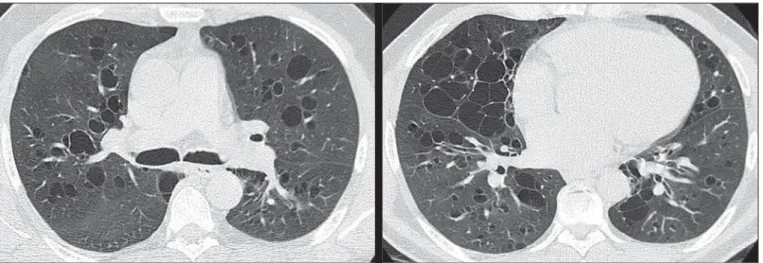XI
Radiol Bras. 2014 Mar/Abr;47(2):XI–XII
Alexandre Dias Mançano1, Rubens Carneiro dos Santos Neto2, Karla Coelho Caixeta e Silva3
0100-3984 © Colégio Brasileiro de Radiologia e Diagnóstico por Imagem
Which is your diagnosis?
Mançano AD, Santos Neto RC, Silva KCC. Which is your diagnosis? Radiol Bras. 2014 Mar/Abr;47(2):XI–XII.
Study developed at Radiologia Anchieta – Hospital Anchieta, Taguatinga, DF, Brazil. 1. MD, Radiologist, Radiologia Anchieta – Hospital Anchieta, Coordinator for Medical Residency at Hospital Regional de Taguatinga, Taguatinga, DF, Brazil. 2. MD, Trainee at Radiologia Anchieta – Hospital Anchieta, Taguatinga, DF, Brazil. 3. MD, Resident
at Hospital Regional de Taguatinga, Taguatinga, DF, Brazil. Mailing Address: Dr. Ale-xandre Dias Mançano. Centro Médico Hospitalar Anchieta, AE 8/10, Setor C Norte, 1º subsolo, Centro de Excelência Anchieta, lojas 12 e 13. Taguatinga, DF, Brazil, 72115-700. E-mail: alex.manzano1@gmail.com.
A 62-year-old man attended the emergency depart-ment, complaining of cough and respiratory distress. The patient denied fever and reported a history of chronic cough that had worsened for the last five years, with crises of res-piratory distress which he had never experienced before. Ac-cording to the patient, he suffered from asthma from his childhood, with bronchitis crises which worsen with physi-cal activity, weather changes or exposure to dust and mold. The patient was formerly a smoker during 26 years and quitted smoking for twenty years. He denied regular
clini-cal follow-up or previous treatments. He usually attends the emergency department and has already been admitted for treatment of some pneumonias. At auscultation, the patient presented with crepitations and stertors in the lung bases and wheezing. Chest radiography was requested and dem-onstrated sparse reticular opacities more extensively located in the right lower lobe, besides bronchiectasis. In order to deepen the investigation, chest computed tomography was requested (Figures 1 and 2).
Figure 1. High resolution computed tomography with sections of the middle and lower pulmonary regions.
XII Radiol Bras. 2014 Mar/Abr;47(2):XI–XII Images description
Figures 1 and 2. Chest computed tomography images demonstrate the presence of thin walled cystic bronchiecta-sis diffusely distributed throughout the lungs. Trachea, main bronchi and lobar bronchi are not affected by the disease.
Diagnosis: Williams-Campbell syndrome.
COMMENTS
Williams-Campbell syndrome is a rare, congenital con-dition caused by a deficiency of cartilage in the subsegmental bronchi, leading to bronchiectasis and distal airways col-lapse(1,2). The cartilage rings deficiency in the fourth- to
sixth-order bronchi results in distal bronchiectasis, with the trachea and main bronchi remaining intact(3).
Such a syndrome is commonly described in children with a history of recurrent pneumonias and obstructive symptoms; and is occasionally diagnosed in adult individu-als(2–4). There are descriptions of familial occurrence, sug-gesting the necessity of investigation of all the family mem-bers(1,5). Clinical symptoms include cough, wheezing and
recurrent pneumonias(1,5). Respiratory function tests
dem-onstrate an obstructive pattern and, in advanced disease may present a mixed pattern. The cartilage deficiency changes the bronchial physiology, causing dilatation dur-ing inspiration and collapse at expiration, determindur-ing hyperinsuflation and segmental/lobar collapse(3,5). Such alteration leads to air trapping, impairing the airway drain-age and resulting in secretion accumulation(3,4). The
recur-rent destruction of the bronchial tree and inappropriate mucus drainage result in parenchymal destruction distally to the bronchiectasis. The symptoms severity and disease prognosis depend on the degree and extent of the cartilage involvement(2).
The imaging finding at conventional radiography cor-responds to symmetrical bronchiectasis. High resolution computed tomography demonstrates distal, cystic bron-chiectasis in fourth- to sixth-order bronchi, with variable extent and no involvement of the trachea and main
bron-chi(2). Normality of the proximal bronchial tree is typical
of the syndrome and is the main finding for differentiation with Mounier-Kuhn syndrome (tracheobronchomalacia)(5,6).
Additionally, mucoid impaction is observed in some bron-chi, predominantly in the lower lobes, besides concomitant findings of infectious disease characterized by a tree-in-bud pattern. Also, a mosaic attenuation pattern may be ob-served(1).
The diagnosis is based on clinical and tomographic findings in addition to the previous and familial history of the patient, besides laboratory tests to rule out other hypoth-eses. No significant finding is observed at bronchoscopy(1,2). The main differential diagnosis is Mounier-Kuhn syn-drome (tracheobronchomalacia), besides alpha-1 antitryp-sin, cystic fibrosis, allergic bronchopulmonary aspergillosis and ciliary diskynesia syndrome(1,2,4).
There is no specific treatment for Williams-Campbell syndrome, and prophylaxis and management of exacerba-tions represent the main method of treatment based on res-piratory physiotherapy and antibiotic therapy. The litera-ture includes the description of some cases of pulmonary transplant, though without great success. In one of such cases, the post-mortem finding was post-transplant brocho-malacia(1,3,7).
REFERENCES
1. Konoglou M, Porpodis K, Zarogoulidis P, et al. Williams-Campbell syndrome: a case report. Int J Gen Med. 2012;5:41–4.
2. Di Scioscio V, Zompatori M, Mistura I, et al. The role of spiral multidetector dynamic CT in the study of Williams-Campbell syn-drome. Acta Radiol. 2006;47:798–800.
3. George J, Jain R, Tariq SM. CT bronchoscopy in the diagnosis of Williams-Campbell syndrome. Respirology. 2006;11:117–9. 4. Cantin L, Bankier AA, Eisenberg RL. Bronchiectasis. AJR Am J
Roentgenol. 2009;193:W158–71.
5. McAdams HP, Erasmus J. Chest case of the day. Williams-Campbell syndrome. AJR Am J Roentgenol. 1995;165:190–1.
